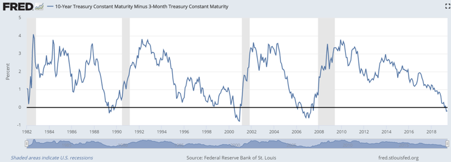Aug
2019
Investing for income: When the Curves go Topsy Turvey
DIY Investor
30 August 2019
When I started out in this industry (and frankly for many years after then), I used to get very confused about yield curves, particularly when they get inverted.
Thankfully, I now realise that it’s quite simple.
The yield curve graphically describes what the interest rate is at various time points. So starting with bonds very close to maturity such as the 3 month gilt (or treasury bill), we can find an effective rate for a short term investment.
As we extend the maturity rate, we can find the rates for 1yr, 2yr, 3yr etc bonds. Typically, curves go out as far as 30 years.
‘yield curve graphically describes what the interest rate is at various time points’
Under ‘normal’ conditions, investors will receive a higher interest rate for investing over lengthier time periods. Intuitively, it is reasonable to expect to receive a higher return if you are prepared to lock up your cash for longer periods. Yields rise as you go along the maturity range and this is a ‘normal’ yield curve.
These normal conditions are helpful for financial businesses such as banks, which tend to take short term deposits from savers and provide longer term loans to borrowers.
An ‘inverted yield curve’ occurs when bonds close to maturity begin to yield more than those with lengthier maturities. The implication is that short term interest rates are unusually high, say perhaps the central bank has lifted interest rates to snuff out inflationary pressures. A yield curve inversion is actually quite rare.
‘an inversion in the US yield curve has presaged a recession’
In the US, the 3 month Treasury currently yields 1.9%, while the 10yr Treasury yields 1.5%. Markets have become more concerned about the sustainability of growth in the economy and the yield curve indicates that short term rates may have to be reduced to stimulate growth.
The worry for investors is that over the last 60 years, an inversion in the US yield curve has presaged a recession, usually with a 12 to 18 month lag.
The last time this occurred was in July 2007. In fact, this indicator has never given a false negative reading (if the inversion persists for at least 3 months). The current inversion occurred in March and is now clearly an increasing cause for concern.
However, the evidence is not quite as clear cut as it seems.
Firstly, a yield curve inversion do not happen often, in fact there have only been half a dozen or so occasions in the US over the last 60 years.
Moreover, yield curves in other government bond markets have inverted without an associated recession.
So, we need to recognise what has happened, but need to seek out other confirmatory data.
While the US economy does seem to be slowing, sentiment indicators remain okay (though are falling from the previously high levels) and many other recessionary indicators have yet to flash warnings.
We remain wary but not despondent.
Visit:
Important Information
This article is for the use of professional advisers and other regulated firms only. It is published by, and remains the copyright of, Square Mile Investment Consulting and Research Ltd (“SM”). SM makes no warranties or representations regarding the accuracy or completeness of the information contained herein. This information represents the views and forecasts of SM at the date of issue but may be subject to change without reference or notification to you. SM does not offer investment advice or make recommendations regarding investments and nothing in this presentation shall be deemed to constitute
financial or investment advice in any way and shall not constitute a regulated activity for the purposes of the Financial Services and Markets Act 2000. This presentation shall not constitute or be deemed to constitute an invitation or inducement to any person to engage in investment activity. Should you undertake any investment activity based on information contained herein, you do so entirely at your own risk and SM shall have no liability whatsoever for any loss, damage, costs or expenses incurred or suffered by you as a result. SM does not accept any responsibility for errors, inaccuracies, omissions or any inconsistencies herein. Past performance is not a guide to future returns.


Leave a Reply
You must be logged in to post a comment.